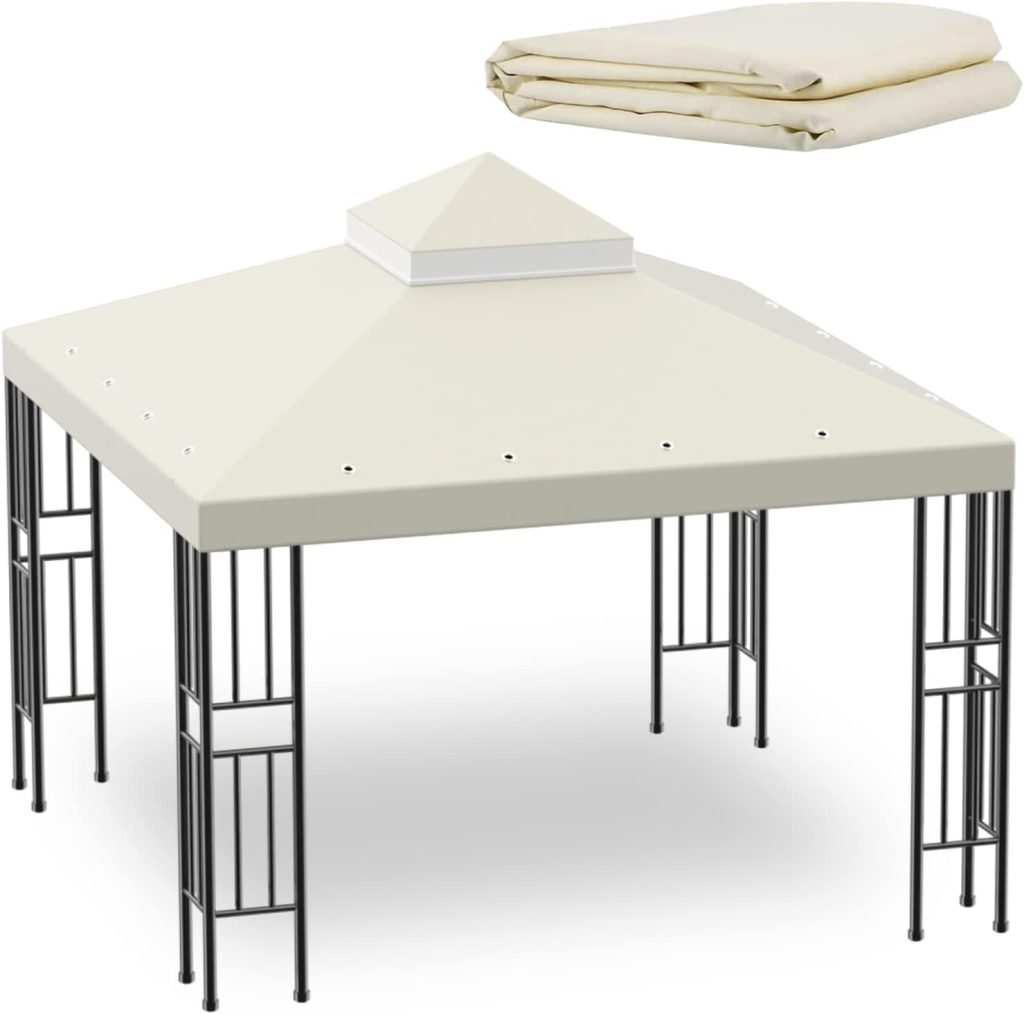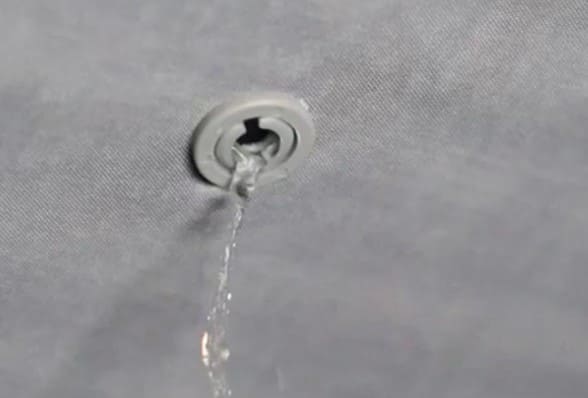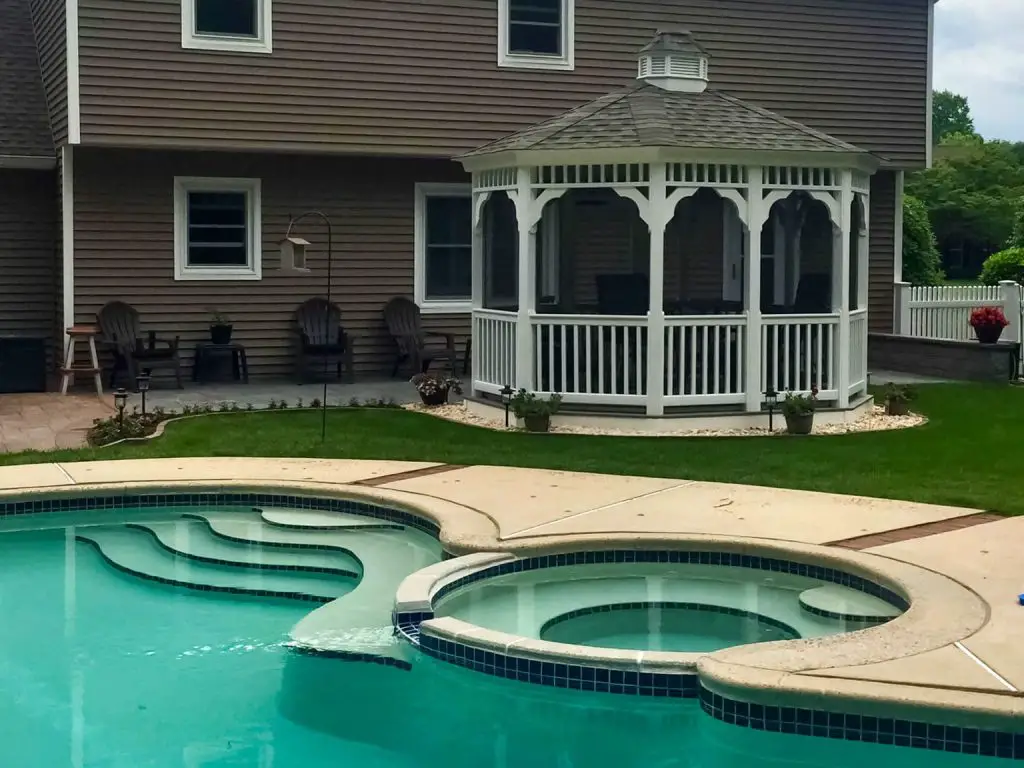I’m thrilled with my gazebo, and one feature that has really stood out to me is the holes it has. These holes serve multiple purposes that have made my gazebo even more functional and convenient.
Firstly, the holes in my gazebo provide added stability. I’ve noticed that they are strategically placed to serve as guide points for stakes or anchors that can be inserted into the ground.
This helps keep my gazebo securely anchored, even during windy conditions, providing peace of mind knowing that my gazebo won’t be easily lifted or moved.
Secondly, the holes have made the installation process a breeze. They act as guides for aligning and positioning the gazebo correctly during assembly, making it much easier and more efficient to set up.
I simply need to line up the holes with the stakes or anchors, and I can quickly and accurately mark the spots where they need to be placed.
Lastly, the holes have also allowed for versatility and customization. I’ve used them to install additional features like screens and lights, giving my gazebo a customized look and feel that fits my preferences and style.
In this article, we’ll explore the reasons why my gazebo has holes.
Why Does My Gazebo Has Holes: These holes serve important purposes such as providing stability during installation, allowing for customization and versatility, and serving as guide points for anchors.
Why Does My Gazebo Has Holes? Understanding Their Purpose
The holes in gazebos serve multiple important functions, including:
Providing Ventilation:

Both hard and soft gazebos are designed with ventilation options to promote air circulation inside the tent, even when walls are attached to the sides of the gazebo.
These ventilation holes are typically located at the top peak of the gazebo and are positioned vertically, rather than following the angle of the roof. To prevent rainwater from entering the gazebo, a two-tier awning is usually installed to cover the holes.
This allows fresh air to flow through the gazebo, creating a comfortable and well-ventilated space for occupants to enjoy, regardless of the type of gazebo and whether or not walls are in place.
Relieving Wind Pressure:
If you plan to set up your gazebo in a windy area, it’s important to choose a durable gazebo made of steel with a wind resistance rating. Look for gazebos that have ventilation holes on the roof, as these allow wind to pass through without damaging the structure. Roof ventilation can also help with wind pressure and resistance.
Additionally, make sure to securely bolt down all four legs of the gazebo to the ground to prevent it from being blown away by strong winds. Taking these precautions will ensure that your gazebo remains stable and safe during windy conditions.
Water Drains from Pools:

If gazebos don’t have holes, there can be several issues. Rainwater can accumulate on the roof, leading to pooling and potential damage to the gazebo structure. Without proper drainage, the weight of the water can cause strain on the roof, leading to sagging or even collapse.
Additionally, hidden pockets of rainwater may collect, causing potential leaks or damage to the gazebo’s roof. Without holes for ventilation, the gazebo may also become stuffy and uncomfortable inside, especially during hot weather.
Overall, having holes in a gazebo is important for proper drainage, ventilation, and structural integrity, preventing potential issues and ensuring the longevity of the structure.
How many Holes should a Gazebo have for Proper Functionality?
Gazebos are designed with four holes in their roof, one for each side of the structure, to facilitate cross-breezes and ensure proper ventilation in various weather conditions.
However, the number of holes may vary depending on the specific gazebo model. Typically, a well-designed gazebo should have at least two to four rooftop holes to ensure adequate ventilation, circulation, and drainage.
It’s important to consider the design and structure of the gazebo when determining the appropriate number of holes for optimal functionality, taking into account factors such as drainage needs, wind resistance, and ventilation requirements.
What are the Consequences of Gazebos Without Holes?
The absence of holes in a gazebo can result in accelerated wear and tear when exposed to rain, sun, and wind, potentially leading to premature damage or deterioration of the structure.
Breaks Could Occur:
Gazebos are designed with holes for a reason, and attempting to cover or block these holes can disrupt the proper functioning of the gazebo. For instance, in a windstorm, a gazebo without ventilation holes can be knocked over by strong winds, and a gazebo without leak holes may collapse under the weight of accumulated rainwater in one area.
Moreover, prolonged exposure to water in certain parts of the gazebo without proper drainage can result in issues like rust, tears, and leaks, which can significantly shorten the lifespan of the structure.
It is essential to maintain the integrity of the gazebo design and ensure that these holes remain unobstructed for optimal performance and durability.
Potential Sagging and Damage:
If your gazebo lacks ventilation holes or leak holes, rainwater can accumulate on the roof, adding excess weight to certain areas that may not be designed to bear it. As a result, the entire structure may sag or become compromised, leading to potential damage or collapse.
Structural Stability

Gazebos are required to be stable and secure, particularly in outdoor environments where they are exposed to various weather conditions such as wind, rain, and other environmental elements.
Ensuring the structural stability of a gazebo is essential to prevent damage or collapse during adverse weather conditions and to provide a safe shelter for its users.
One crucial aspect of gazebo stability is the presence of holes in its design. These holes can serve as guide points for stakes or anchors to be inserted into the ground, providing additional stability.
By aligning the gazebo legs with these holes and securing stakes or anchors through them into the ground, the gazebo can be anchored firmly to the surface, preventing it from being easily lifted or moved during windy conditions.
To secure stakes or anchors through the holes, they can be driven into the ground at an appropriate depth, depending on the ground type and weather conditions.
The gazebo legs can then be attached to the stakes or anchors, providing a stable connection between the gazebo and the ground. This anchoring system helps to prevent lateral movement of the gazebo, ensuring it remains stable even during gusty winds or heavy rainfall.
It is important to use suitable stakes or anchors that are designed for the specific ground type and weather conditions to ensure maximum stability.
In addition, proper installation of stakes or anchors and regular maintenance to ensure they remain secure over time is crucial for the long-term stability of the gazebo.
Overall, gazebos require structural stability to withstand outdoor weather conditions. The holes in a gazebo can serve as guide points for stakes or anchors, which can be secured into the ground to provide additional stability.
Proper installation and maintenance of stakes or anchors can prevent the gazebo from being easily lifted or moved during windy conditions, ensuring its stability and durability.
Versatility and Customization
Gazebos are available in a wide range of designs, sizes, and materials, making them versatile and customizable to suit different preferences and needs. Whether you prefer a classic wooden gazebo or a modern metal one, there are options available to match your style and outdoor space requirements.
The holes in a gazebo can offer versatility in customization, as they can serve various purposes based on the specific needs of the gazebo owner.
For instance, these holes can be used to install additional features such as screens or curtains to provide privacy, shade, or protection from insects.
They can also be used to attach shelves or hooks for storage or to hang decorations, lights, or plants, adding a personalized touch to the gazebo and enhancing its aesthetics.
Furthermore, the customization options with gazebo holes allow you to adapt the gazebo to different weather conditions or events.
For example, you can use the holes to install temporary or removable accessories like Christmas lights during the holiday season or adjust the curtains or screens to provide more ventilation during hot summer days, or block out wind and rain during inclement weather.
Overall, the holes in a gazebo provide versatility and customization options, allowing gazebo owners to tailor their outdoor space according to their preferences, needs, and changing weather conditions or events.
With the ability to add various features or decorations through these holes, gazebos become not just functional shelters but also personal and unique outdoor sanctuaries.
Stability in Challenging Environments

Gazebos are often installed in various outdoor environments, including uneven or sloped terrains, which can pose challenges to proper alignment and stability.
However, the holes designed as guide points in gazebos can play a crucial role in stabilizing the structure in such environments.
The holes in a gazebo serve as guide points for stakes or anchors, which can be inserted into the ground to provide stability. In challenging terrains, such as uneven or sloped ground, these holes can help ensure that the gazebo is properly aligned and stable.
By securing the stakes or anchors through the holes, the gazebo can be anchored firmly to the ground, preventing any wobbling or tilting even on uneven surfaces.
Furthermore, the stakes or anchors used with gazebo holes can be adjusted to different heights or angles based on the holes’ positioning. This allows for fine-tuning of the gazebo’s stability, ensuring that it remains level and secure even on uneven ground.
This adjustability allows gazebo owners to overcome challenges posed by challenging terrains and enjoy a stable and safe gazebo setup.
Overall, the holes in gazebos serve as guide points for stakes or anchors, offering stability in challenging environments such as uneven or sloped terrains.
The ability to adjust the stakes or anchors based on the holes’ positioning allows for proper alignment and stability of the gazebo, ensuring a safe and reliable outdoor shelter, even in challenging outdoor conditions.
Aesthetics
The holes for guide points in gazebos can also serve aesthetic purposes, adding to the overall visual appeal of the structure.
Some gazebo designs may intentionally incorporate these holes as part of their aesthetic appeal, enhancing the gazebo’s design and aesthetics.
Strategic placement of holes can be used to create interesting patterns or enhance the gazebo’s overall design. For example, holes can be strategically positioned to create patterns or motifs that add visual interest to the gazebo’s walls, roof, or other structural elements.
This can add a unique and decorative touch to the gazebo, making it a visually appealing focal point in any outdoor space.
Furthermore, the holes can also be used to add functional and decorative elements to the gazebo. For instance, they can be used to install screens, curtains, or other decorative features that not only enhance the aesthetics but also provide practical benefits such as privacy, shade, or insect protection.
Overall, the holes for guide points in gazebos can serve aesthetic purposes by enhancing the overall design and visual appeal of the structure.
Strategic placement of holes can create interesting patterns and motifs, adding a decorative touch to the gazebo while also offering functional benefits.
Ease of Installation
The holes in a gazebo can greatly facilitate the installation process, making it easier and more efficient. These holes can serve as guides for aligning and positioning the gazebo correctly during assembly, ensuring that it is properly set up.
By aligning the holes with the stakes or anchors, the gazebo can be quickly and accurately secured to the ground, saving time and effort during installation.
The holes act as reference points, helping to ensure that the gazebo is level and stable, and preventing it from shifting or moving once it is assembled.
The use of these holes as guides can streamline the installation process, allowing for faster and more precise installation of the gazebo.
This can be particularly beneficial in challenging environments, such as uneven or sloped terrains, where proper alignment and stability are crucial for the gazebo’s overall performance.
In addition, the holes can also aid in the disassembly and reassembly of the gazebo, making it convenient for temporary or seasonal installations.
By aligning the holes with the stakes or anchors during disassembly, it becomes easier to accurately reassemble the gazebo in the same location or a different location without losing alignment or stability.
Overall, the holes in a gazebo can significantly enhance the ease of installation by serving as guides for alignment and positioning, allowing for quick and accurate securing to the ground, and simplifying disassembly and reassembly processes.
FAQs:
Q:1 What is the purpose of grommet holes in a gazebo?
The holes in a gazebo are designed for drainage. If the top cover is not tightly strapped to the top-edge rails or bars, it can sag when it gets wet, causing water to pool inside the top rail. The holes allow the water to drain out, preventing the top from ripping.
Q:2 What are the circular openings in tarps called?
These openings are commonly referred to as grommets or eyelets, and they play a crucial role in securing the tarp and preventing it from getting damaged or blown away by the wind.
Q:3 What characteristics make a gazebo considered permanent?
Permanent gazebos are garden structures that are intended to be set up for a long period of time. They are typically made of materials like wood, plastic, or composite, and come with a shingle, shake, or metal roof, as well as a floor. These gazebos are anchored securely in place to withstand wind and weather.
Q:4 How can you prevent a gazebo canopy from tearing?
To waterproof your canopy, use a can of waterproof spray and cover the entire canopy. Hold the can about 8 inches away from the material and spray at an angle for best coverage.
It’s recommended to apply two coats to make sure the canopy is fully protected. Let it dry, and then repeat the process on the other side of the fabric.
Q:5 What is the significance of grommet holes in gazebos?
A grommet is a small metal circle that goes around a hole where you thread a cord or cable through. It’s like the eyelets on your shoelaces that you thread your shoelaces through when lacing up your shoes.
Grommets are used in various ways, including in boots, shoes, and other applications, to help protect the holes and make threading cords or cables easier.
Q:6 Why do gazebos often have vents?
The holes or openings on the top of your gazebo are designed to allow heat and smoke to escape. These vents help to keep the gazebo well-ventilated and prevent the build-up of heat or smoke inside.
There are two types of roof vent designs: single-tier, which has one layer of vents, and double-tier, which has two layers of vents.
Conclusion:
In conclusion, the presence of holes in your gazebo serves several crucial purposes, making them an essential feature of the structure. These holes are strategically designed to enhance the versatility, customization, stability, and aesthetics of your gazebo.
Firstly, the holes in the gazebo provide stability and security, especially in challenging outdoor environments such as uneven terrains. By aligning the holes with stakes or anchors, the gazebo can be properly secured to the ground, ensuring stability and proper alignment.
Secondly, the holes offer customization options, allowing you to add additional features such as screens, curtains, shelves, decorations, lights, or plants. This enables you to personalize your gazebo based on your specific needs and preferences, making it a unique and functional space.
Thirdly, the holes can have aesthetic purposes, with some gazebo designs incorporating them as part of their overall design, creating interesting patterns or enhancing the visual appeal of the structure. This adds to the gazebo’s aesthetic value, making it a visually appealing addition to your outdoor space.
Furthermore, the holes in the gazebo assist in the installation process, serving as guides during assembly and ensuring that the structure is properly set up. This saves time and effort, making the installation process more efficient and convenient.
In addition, the holes in the gazebo can also provide ventilation, allowing heat and smoke to escape, which can be beneficial during hot or smoky weather conditions.
We hope you will be well aware of why my gazebo has holes, after reading this comprehensive article. If you have any questions, feel free to comment below!

